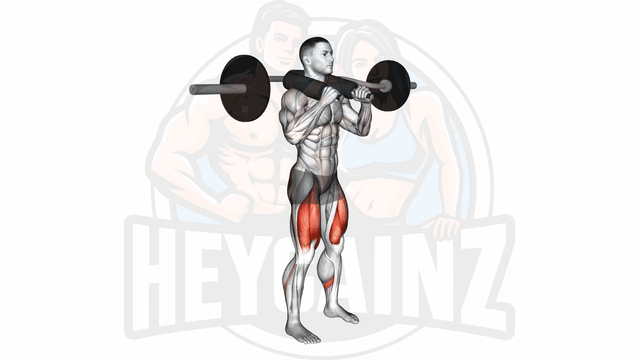
Instructions:
- 1Place the bar on your shoulders, keeping the elbows high
- 2Lower your body by bending the knees, keeping your back straight
- 3Pause at the bottom of the squat, then push back up to the starting position
- 4Keep your core engaged throughout the movement
Tips:
- Keep your knees in line with your toes
- Ensure your body weight is on your heels, not your toes
- Try to keep your torso as upright as possible throughout the exercise
Understanding the Safety Bar Front Squat
The Safety Bar Front Squat is an effective lower body exercise that targets the thighs while providing additional stability, thanks to the unique design of the safety squat bar. This exercise is particularly beneficial for individuals looking to enhance their squat technique without the stress on the shoulders typically experienced with a traditional front squat.
While the safety squat bar offers a different feel compared to a standard front squat, many find it easier to maintain proper posture throughout the movement. This can be especially helpful for those with limited shoulder mobility or discomfort when using a standard barbell. The added padding and design allow users to focus on form and depth, making it a great option for lifters at all levels.
When comparing the Safety Bar Squat to the traditional front squat, many individuals report that the safety squat bar feels more comfortable, thereby enabling them to lift heavier weights with enhanced safety. In online discussions, such as on Reddit, users often share their experiences comparing the Safety Bar vs Front Squat, highlighting the advantages of stability and comfort.
To get the most out of your Safety Bar Front Squat, consider the following tips:
- Warm Up: Always ensure your body is properly warmed up before starting any squatting exercise to prevent injuries.
- Foot Placement: Position your feet shoulder-width apart for optimal balance and control.
- Core Engagement: Keep your core tight throughout the movement to maintain stability and protect your back.
- Depth Awareness: Aim to squat to at least parallel, ensuring your knees are not extending beyond your toes for better alignment.
Whether you are new to strength training or an experienced lifter, incorporating the Safety Bar Front Squat into your workout regimen can enhance your lower body strength and overall performance. It’s a versatile exercise that caters to a wide range of fitness levels, proving beneficial for anyone looking to improve their squat technique.